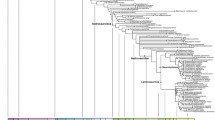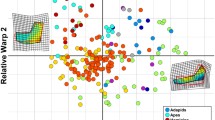Abstract
The Eocene Notharctinae provide a record of increasing fusion of the mandibular symphysis. The two sympatric genera,Notharctus andSmilodectes, differed through time in two respects.Notharctus increased in body size and evolved a partially fused mandibular symphysis.Smilodectes changed little in body size and retained an unfused symphysis. Similarities in molar morphology between these two genera and extant leaf-eating mammals suggest thatNotharctus andSmilodectes were specialized for folivory, a dietary regime correlated with partial symphyseal fusion in many extant mammals. It is concluded that the presence and the extant of symphyseal fusion is a function of body size, diet, and jaw mechanics, complicated by lineagespecific factors that vary among higher mammalian taxa.
Similar content being viewed by others
References
Beecher, R. M. (1977). Function and fusion at the mandibular symphysis.Am. J. Phys. Anthropol. 47: 325–336.
Beecher, R. M. (1979). Functional significance of the mandibular symphysis.J. Morphol. 159: 117–130.
Elliott, D. G. (1912). A review of the primates.Monogr. Am. Mus. Nat. Hist. I–III.
Gingerich, P. D. (1977). New species of Eocene primates and the phylogeny of European Adapidae.Folia Primtol. 28: 60–80.
Gingerich, P. D. (1979). Phylogeny of middle Eocene Adapidae (Mammalia, Primates) in North America:Smilodectes andNotharctus.J. Paleontol. 53: 153–163.
Gingerich, P. D., and Schoeninger, M. (1977). The fossil record and primate phylogeny.J. Hum. Evol. 6: 483–505.
Gingerich, P. D., and Simons, E. L. (1977). Systeniatics, phylogeny, and evolution of early Eocene Adapidae (Mammalia, Primates) in North America.Contr. Mus. Paleontol. Univ. Mich. 24(22): 245–279.
Gregory, W. K. (1920). On the structure and relations ofNotharctus, an American Eocene primate.Monogr. Am. Mus. Nat. Hist. 3(2): 49–243.
Kay, R. F. (1975). The functional adaptations of primate molar teeth.Am. J. Phys. Anthro-pol. 43: 195–216.
McKenna, M., Russell, D., West, R., Black, C, Turnbull, W., Dawson, M., and Lillegraven, J. (1973). K/Ar recalibration of Eocene North American land-mammal “ages” and European ages.Geol. Soc. Amer. Abstr. Prog. 5: 733.
Radinsky, L. (1977). Brains of early carnivores.Paleobiology 3: 333–349.
Rigler, L., and Mlinsek, B. (1968). Die Symphyse der Mandibula beim Rinde: Ein Beitrag zur Kenntnis ihrer Struktur und Funktion.Anat. Anz. 122: 293–314.
Robinson, P. (1957). The species ofNotharctus from the middle Eocene.Postilla 28: 1–23.
Scapino, R. P. (1965). The third joint of the canine jaw.J. Morphol. 116: 23–50.
Scapino, R. P. (1981). Morphological investigation into functions of the jaw symphysis in carnivores.J. Morphol. 167: 339–375.
Schoeninger, M. J. (1976). Functional significance of the development of a mesostyle in the Eocene primatesPelycodus andNotharctus.Am. J. Phys. Anthropol. 44: 204.
Simons, E. L. (1972).Primate Evolution: An Introduction to Man’s Place in Nature, Mac-millan, New York.
Stehlin, H. G. (1912). Die SÄugetiere des schweizerischen EocÄns. Critischer Catalog der Materialien, 7ter Thiel, erste Halfte.Adapts. Abh. Schweiz. PalÄontol. Ges. 41: 1299–1552.
Tattersall, I. (1973). Cranial anatomy of the Archaeolemurinae (Lemuroidea, Primates).Am. Mus. Nat. Hist. Anthropol. Papers 52(1): 1–110.
Vaughan, T. A. (1978).Mammalogy, W. B. Saunders, Philadelphia.
Author information
Authors and Affiliations
Rights and permissions
About this article
Cite this article
Beecher, R.M. Evolution of the mandibular symphysis in Notharctinae (Adapidae, Primates). Int J Primatol 4, 99–112 (1983). https://doi.org/10.1007/BF02739362
Received:
Issue Date:
DOI: https://doi.org/10.1007/BF02739362




